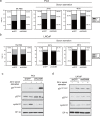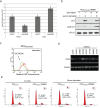In vivo targeting of ADAM9 gene expression using lentivirus-delivered shRNA suppresses prostate cancer growth by regulating REG4 dependent cell cycle progression
- PMID: 23342005
- PMCID: PMC3547060
- DOI: 10.1371/journal.pone.0053795
In vivo targeting of ADAM9 gene expression using lentivirus-delivered shRNA suppresses prostate cancer growth by regulating REG4 dependent cell cycle progression
Abstract
Cancer cells respond to stress by activating a variety of survival signaling pathways. A disintegrin and metalloproteinase (ADAM) 9 is upregulated during cancer progression and hormone therapy, functioning in part through an increase in reactive oxygen species. Here, we present in vitro and in vivo evidence that therapeutic targeting of ADAM9 gene expression by lentivirus-delivered small hairpin RNA (shRNA) significantly inhibited proliferation of human prostate cancer cell lines and blocked tumor growth in a murine model of prostate cancer bone metastasis. Cell cycle studies confirmed an increase in the G1-phase and decrease in the S-phase population of cancer cells under starvation stress conditions, which correlated with elevated intracellular superoxide levels. Microarray data showed significantly decreased levels of regenerating islet-derived family member 4 (REG4) expression in prostate cancer cells with knockdown of ADAM9 gene expression. This REG4 downregulation also resulted in induction of expression of p21(Cip1/WAF1), which negatively regulates cyclin D1 and blocks the G1/S transition. Our data reveal a novel molecular mechanism of ADAM9 in the regulation of prostate cancer cell proliferation, and suggests a combined modality of ADAM9 shRNA gene therapy and cytotoxic agents for hormone refractory and bone metastatic prostate cancer.
Conflict of interest statement
Figures







References
-
- Bubendorf L, Schopfer A, Wagner U, Sauter G, Moch H, et al. (2000) Metastatic patterns of prostate cancer: an autopsy study of 1,589 patients. Hum Pathol 31: 578–583. - PubMed
-
- McMurtry CT, McMurtry JM (2003) Metastatic prostate cancer: complications and treatment. J Am Geriatr Soc 51: 1136–1142. - PubMed
-
- Villavicencio H (1993) Quality of life of patients with advanced and metastatic prostatic carcinoma. Eur Urol 24 Suppl 2118–121. - PubMed
-
- Coleman WB, Tsongalis GJ (1995) Multiple mechanisms account for genomic instability and molecular mutation in neoplastic transformation. Clin Chem 41: 644–657. - PubMed
-
- Berthold DR, Pond GR, Soban F, de Wit R, Eisenberger M, et al. (2008) Docetaxel plus prednisone or mitoxantrone plus prednisone for advanced prostate cancer: updated survival in the TAX 327 study. J Clin Oncol 26: 242–245. - PubMed
Publication types
MeSH terms
Substances
LinkOut - more resources
Full Text Sources
Other Literature Sources
Medical
Research Materials
Miscellaneous

